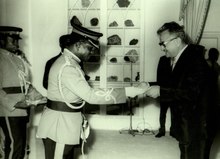Letter of credence

Aletter of credence(French:Lettre de créance) is a formaldiplomatic letterthat designates a diplomat asambassadorto another sovereign state. Commonly known asdiplomatic credentials,the letter is addressed from onehead of stateto another, asking them to givecredence(French:créance) to the ambassador's claim of speaking for their country. The letter is presented personally by the ambassador-designate to the receiving head of state in a formal ceremony, marking the beginning of the ambassadorship.
Letters of credence are traditionally written in French, thelingua francaof diplomacy.[1]However, they may also be written in the official language of the sending state.[2][3]
Language of letters[edit]
Letters of credence between two monarchs of equal rank will typically begin with the salutation "Sir My Brother" (or "Madame My Sister", in the case of a female monarch) and close with the valediction "Your Good Brother" (or Sister, in the case of a female monarch).
Presentation of credentials[edit]



Upon arrival at their post, the ambassador-designate meets with the foreign minister to arrange for an audience with the head of state.[4]They bring both a sealed original and an unsealed copy of his credentials. The unsealed copy is given to the foreign minister upon arrival, and the original is presented personally to the head of state in a formal ceremony.[5]: 550 Ambassadors do not begin their duties until their credentials are accepted, and their precedence within thediplomatic corpsis determined by the date on which the credentials were presented.[6]They are, however, entitled todiplomatic immunityas soon as they enter the country.[7]: 32 [8]: 261
The ambassador-designate travels to the presentation ceremony in an official vehicle provided by the receiving state, accompanied by a military escort. Inconstitutional monarchiesandparliamentary democracies,thehead of stateorviceroyacts according to legally-binding advice from thegovernment.The foreign minister willattend(be present with) the head of state at the actual ceremony, to symbolize the fact that the credentials are being accepted on the basis of government advice.[9]The ambassador-designate uses both hands to present their credentials to the head of state.[10]
Many governments hold presentation ceremonies with elements that are usually accorded to heads of state and government, like military honors.
While credential ceremonies are among the most formal events in diplomacy, governed by strict protocols and detailed guidelines, variations in the nature of these ceremonies can still be observed among diplomats from different countries. Despite their scripted and calculated nature, these ceremonies offer state representatives a subtle yet significant space for signaling— positive or negative — establishing contact, or conveying messages.[11]
Chargé-level relations[edit]
When two countries maintain relations at thechargé d'affaireslevel, the letter of credence will be written by the foreign minister of the sending state and addressed to the foreign minister of the receiving state. The chargé will present their credentials to the foreign minister.[12]The head of state is neither addressed nor presented with the credentials, symbolizing the lower level of diplomatic relations between the countries. The chargé is not entitled to a military escort or an official car.
Commonwealth[edit]
High commissionersfromCommonwealthnations do not present letters of credence. When twoCommonwealth realmsshare the samemonarchas head of state, theprime ministerof the sending state writes an informal letter of introduction to the prime minister of the receiving state.[13]When a Commonwealth nation is a republic or has its own separate monarch, high commissioners are dispatched and received with letters of commission, which are written by one head of state and presented to another head of state.[14][15]Both forms of letters were standardized in 1950–1951 after India became a republic, replacing a chaotic system where some high commissioners carried letters from the prime minister, some carried letters from the minister of external relations, and others carried no letters at all.[16]
References[edit]
- ^"10th Anniversary of Poland's Accession to the EU".Ministry of Foreign Affairs, Republic of Poland.8 May 2014. Archived fromthe originalon 19 April 2018.Retrieved20 March2016.
Letters of Credence (translated from French) of Jan Kułakowski, 26 February 1990 (AMFA).
- ^Ahren, Raphael (October 17, 2012)."New Egyptian ambassador brings Israel 'message of peace'".The Times of Israel.Archivedfrom the original on September 10, 2020.RetrievedMarch 20,2016.
- ^"Diplomatic Credential Presented by the Great Qing Empire".National Palace Museum.Archived fromthe originalon 2016-04-02.Retrieved2016-03-21.
- ^"2 FAM 330 Ceremonies and Protocol Upon Assignment as Chief of Mission"(PDF).U.S. Department of State. February 28, 2012.Archived(PDF)from the original on November 2, 2021.RetrievedMay 25,2019.
The new chief of mission requests, through the officer who has been acting as chargé d'affaires ad interim, an informal conference with the minister of foreign affairs or such other appropriate officer of the government in order to arrange to be received by the chief of state.
- ^Oppenheim, Lassa (1905).International Law: A Treatise.Vol. I.
- ^"Diplomatic List: Order of Precedence and Date of Presentation of Credentials".Office of the Chief of Protocol, U.S. Department of State.11 March 2005.Archivedfrom the original on 7 March 2021.Retrieved23 March2016.
- ^Dopagne, Frédéric; Hay, Emily; Theeuwes, Bertold F. (2 June 2014). Theeuwes, Bertold F. (ed.).Diplomatic Law in Belgium.Maklu.ISBN9789046606865.
- ^Satow, Ernest Mason (2017).Satow's Diplomatic Practice(7th ed.). Oxford University Press.ISBN9780198739104.
- ^"Presentation of Credentials".Ministry of Foreign Affairs of the Republic of Cyprus.Archived fromthe originalon November 15, 2013.RetrievedMarch 20,2016.
The President of the Republic invites the Ambassador in his Office, for an audience. The Minister of Foreign Affairs and the Director of the Office of the President, also attend.
- ^"Procedure for Presenting the Letters of Credence by the Head of Diplomatic Mission in Montenegro".Ministry of Foreign Affairs and European Integration (Montenegro).Archived fromthe originalon 2017-06-01.Retrieved2016-03-20.
Then he/she approaches the President of Montenegro and formally (with both hands) presents to him the Letter of Credence and the Letter of Recall of his/her predecessor. The President of Montenegro formally accepts the letters and shakes hands with the Head of Diplomatic Mission.
- ^Roni Berkowitz, Gadi Heimann, Zohar Kampf, Communicating through Protocols: The Case of Diplomatic Credential Ceremonies, International Political Sociology, Volume 18, Issue 2, June 2024, olae013,https://doi.org/10.1093/ips/olae013
- ^U.S. Department of State (1897).Instructions to the Diplomatic Officers of the United States.Washington, DC. pp.1–5.
{{cite book}}:CS1 maint: location missing publisher (link) - ^Alison Quentin-Baxter and Janet McLean,This Realm of New Zealand: The Sovereign, the Governor-General, the Crown,2017
- ^Berridge, G. R.; Lloyd, Lorna (2012). "Letter of introduction".The Palgrave Macmillan Dictionary of Diplomacy(3rd ed.). Palgrave Macmillan. p. 229.ISBN9780230302990.
- ^Berridge, G. R.; Lloyd, Lorna (2012). "Letters of commission".The Palgrave Macmillan Dictionary of Diplomacy(3rd ed.). Palgrave Macmillan. p. 230.ISBN9780230302990.
- ^Lloyd, Lorna (2007).Diplomacy with a Difference: the Commonwealth Office of High Commissioner, 1880-2006.Martinus Nijhoff. pp. 138–140.ISBN9789047420590.
